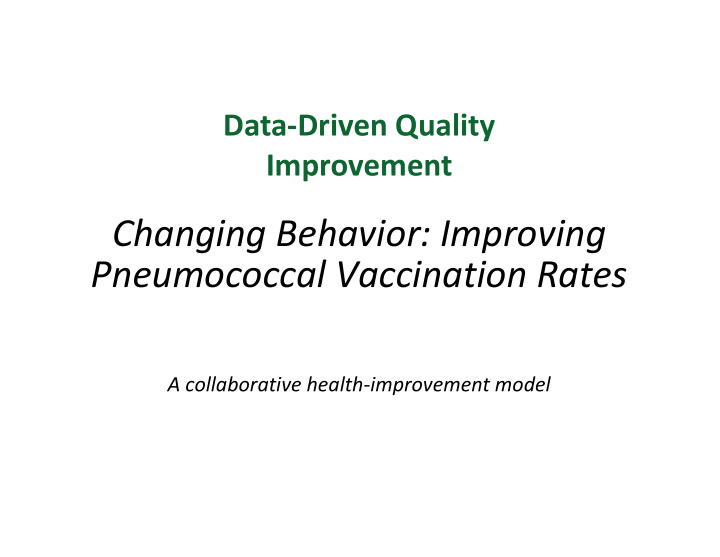



Data-Driven Quality Improvement Changing Behavior: Improving Pneumococcal Vaccination Rates A collaborative health-improvement model
Data-Driven Educational Model n Clinical performance dashboard (CPD): baseline and trimester reports of each participant’s clinical performance n Faculty consensus meetings: representation from physician champions, experts in pneumococcal vaccination, medical education, case management and care coordination, clinical informatics, and quality improvement n Online CME educational activities: directly address the most significant performance gaps n Literature search: capturing the most recent information and clinical advances pertaining to vaccination and its impact on patient morbidity and mortality n Longitudinal outcomes report: populated with aggregate, de-identified data showing trends in vaccination rates in each region and system wide
Pneumococcal Vaccination Demographics n Participating health systems: – Community Physicians of Indiana (Indianapolis, Indiana) – Holston Medical Group (Kingsport, Tennessee) – Sentara Medical Group (Norfolk, Virginia) n Participating physicians: 320 primary care physicians n Eligible patients: – Age ≥ 65 years: 105,482 – Age ≥ 18 years at high risk* of pneumococcal infection: 162,675 * Due to chronic medical comorbidities (cardiovascular disease, including stroke; liver, kidney, or lung disease, including chronic renal disease, asthma, and diabetes); immunocompromising diseases (eg, lymphoma, leukemia) or immunosuppressive therapy (eg, corticosteroid therapy, radiotherapy); HIV/AIDS; environmental and occupational risks (eg, skilled nursing facility); cochlear implants; cerebrospinal fluid leakage; alcoholism; and/or cigarette smoking
Pneumococcal Vaccination Website
Pneumococcal VAX Clinical Performance Dashboard
Impact on Number of Patients Vaccinated Number Number Number Change from baseline Number Finished vaccinated vaccinated Patient group of eligible in number of patients physicians CME? at baseline at final patients vaccinated assessment assessment Elderly 103 Yes 35,384 20,853 26,345 + 5,492 + 26.3% 217 No 70,098 43,362 52,630 + 9,268 + 21.4% Total 320 – 105,482 64,215 78,975 + 14,760 + 23.0% High-risk 103 Yes 61,326 8,786 12,661 + 3,875 + 44.1% 217 No 101,349 14,576 19,645 + 5,069 + 34.8% Total 320 – 162,675 23,362 32,306 + 8,944 + 38.3%
Conclusions n Nearly a third (103/320) of the primary care physicians who participated in this program completed the CME educational activities offered and received 20 AMA PRA Credits ™. n The program was successful in driving up pneumococcal vaccination rates: a total of 14,760 elderly patients and 8,944 patients at high risk of pneumococcal infection in just three medical groups were vaccinated post baseline over the program’s two-year course. n Access to the Clinical Performance Dashboard alone improved pneumococcal vaccination rates by 20% to 42%. n In addition, finishing the PI CME program worked even better, improving pneumococcal vaccination rates by 22% to 56%.
Conclusions n The program achieved its educational objectives, reaching both Moore’s Level 5 (Performance) and Level 6 (Patient Health Status). n The Data Driven Quality Improvement Model was recognized by the Centers for Disease Control (CDC): – Invited to join a Vaccine Provider Work Group – Introduced to leadership of HHS – Introduced to leadership of National Adult & Influenza Summit (NAIIS) n NAIIS 2016 authored a poster on the program and presented at their conference
Recommend
More recommend